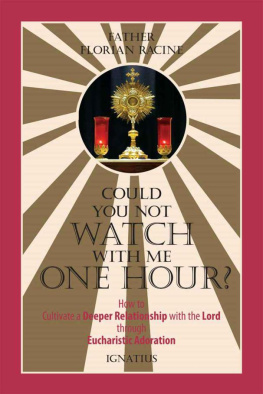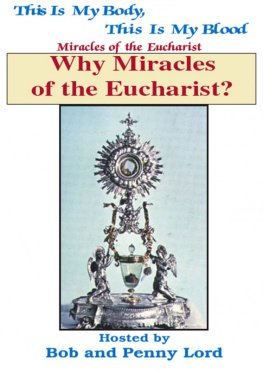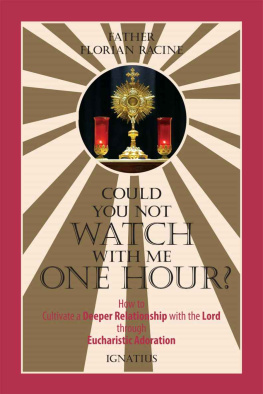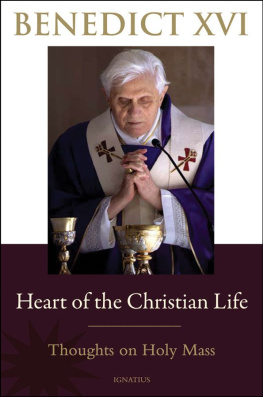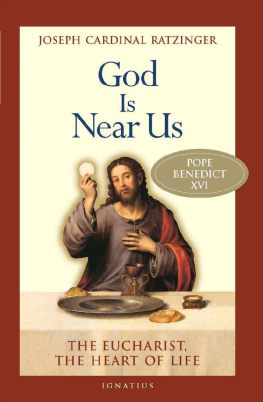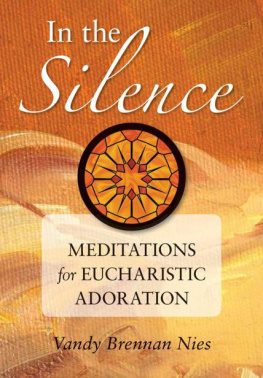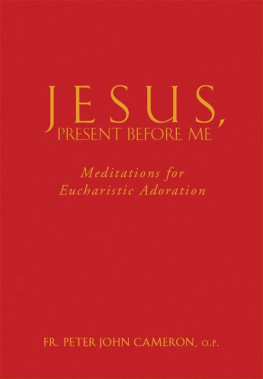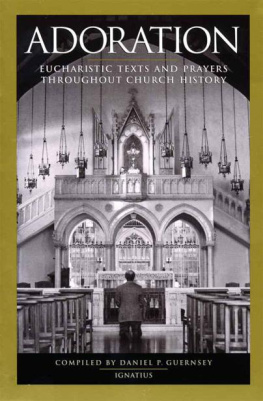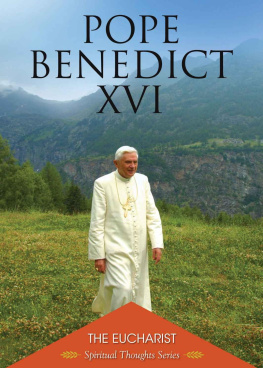Could You Not Watch with Me One Hour?
FLORIAN RACINE
Could You Not Watch with Me One Hour?

How to Cultivate a Deeper
Relationship with the Lord through
Eucharistic Adoration
TRANSLATED BY C. A. THOMPSON-BRIGGS
IGNATIUS PRESS SAN FRANCISCO
Original French edition:
Adorer sans se lasser
2011 by ditions de lEmmanuel, Paris
Unless otherwise noted, all Scripture quotations (except those included within citations) have been taken from the Revised Standard Version of the Holy Bible, Second Catholic Edition, 2006. The Revised Standard Version of the Holy Bible: the Old Testament, 1952, 2006; the Apocrypha, 1957, 2006; the New Testament, 1946, 2006; the Catholic Edition of the Old Testament, incorporating the Apocrypha, 1966, 2006; the Catholic Edition of the New Testament, 1965, 2006 by the Division of Christian Education of the National Council of the Churches of Christ in the United States of America. All rights reserved.
Unless otherwise indicated, all translations of papal and curial documents have been taken from the Vatican website.
Front cover photograph by AgnusImages.com
Cover design by Davin Carlson
2014 by Ignatius Press, San Francisco
All rights reserved
ISBN 978-1-58617-777-5
Library of Congress Control Number 2014908820
Printed in the United States of America
CONTENTS
Outline of the Itinerary (52 weeks)
by Bishop Guy de Kerimel
The Lord Comes to Me, He Calls Me, I Respond to Him ( twenty-seven stages )
God Comes to Meet Me (seven stages)
I Respond, by Faith, to His Love (seven stages)
The Signs of the Covenant (thirteen stages)
Through the Son, Ascending to the Father and Letting Oneself Be Transformed by His Love ( ten stages )
He Is the Good Shepherd Who Leads Me to the Father
(allowing oneself to love) (five stages)
Spiritual Warfare (from sensible graces to the adoration of the Father in spirit and truth) (five stages)
Animated by the Spirit, Engaging in the Churchs Mission ( fourteen stages )
In the School of Mary, Eucharistic and Missionary Woman (three stages)
The Living Water that Flows from the Pierced Heart (three stages)
All Things New (three stages)
The Five Graces of Adoration and Mission (five stages)
FOREWORD
Indeed, practicing Eucharistic adoration leads to living the celebration of the Mass more intensely and bears evident fruit: In consequence, the devotion which leads the faithful to visit the Blessed Sacrament draws them into an ever deeper participation in the Paschal Mystery. It leads them to respond gratefully to the gift of Him who through His humanity constantly pours divine life into the members of His body (ibid.). Father Florian Racine has gathered and quoted some testimonies of the fruits of Eucharistic adoration; I am thinking in particular of that of Mother Teresa, who saw a positive change in her community starting from the moment the Sisters began adoring the Blessed Sacrament exposed to their gaze. This book expresses the strong conviction of the fruitfulness of adoration of the Blessed Sacrament.
When practiced superficially, Eucharistic adoration is perceived as a custom that provokes the enthusiasm of pious and sensitive souls or the annoyance of those who fear a reification of the Eucharist. The former are seeking a perceptible experience of the living Jesus, a heart-to-heart that can wind up being very self-centered; the latter hold that keeping oneself on ones knees before a monstrance stems from narrow-minded devotion.
In this book Father Florian Racine offers us a formation in Eucharistic adoration that will enable practicing it in all its depth and with a missionary perspective. This program seeks to confirm believers in the validity of Eucharistic adoration, just as it seeks to open a journey of faithof growth and perseverance in faithto adorers, so that they become worshippers in spirit and truth: But the hour is coming, and now is, when the true worshipers will worship the Father in spirit and truth, for such the Father seeks to worship him (Jn 4:23). If God is present everywhere, he has made himself particularly close to mankind in Jesus his Son. The redemptive Incarnation of his Son is the means chosen by God for reconciling mankind and all creation with himself; the death and Resurrection of Christ are the only path to the Father; the memorial of the Passover of Christ is therefore at the heart of our relationship with God. In the Blessed Sacrament, the delivered and resurrected Jesus is really present and acting; he draws all mankind into his filial relationship with the Father, through the power of the Holy Spirit. Thus, it is logical that, in accordance with the plan of God, believers put the Eucharist at the heart of their life and take time to adore Jesus in this Sacrament. The adorer wants to abide within the dynamic of the Eucharist, just as he wishes also that the Eucharist might transform all his life.
The Teacher is here and is calling for you (Jn 11:28). Tied to the celebration of the Eucharist, well-practiced adoration of the Blessed Sacrament unites the believer to Jesus and through him to the Father, builds up the Church, supports her mission in the world, and elevates and transforms creation.
Like every form of prayer, Eucharistic adoration has its stages. Our pilgrimage of faith begins with welcoming the gift of God; the spiritual life experiences, at first, some of the personal love that God bears for us: the coming of Christ before us and into our life; sensible graces can thus be frequent. This first step gives way to a deeper and less sensible path of faith, which through trials and consolations decenters us from ourselves in order to center us on God. Through Jesus, with him and in him, in the Holy Spirit, we are turned toward the Father; we seek to enter into his sight and to do his will. Then, at the inspiration of the Holy Spirit, we are commissioned. Adoration and Eucharistic life transform believers into the image of Christ by incorporating them into his ecclesial Body and makes of their person an offering to the glory of God for the salvation of the world.
The fifty-two stages are grouped into three phases corresponding to the three theological virtues: I adore the Son, I adore the Father through the Son, I adore the Father through the Son, in the Spirit. These phases lead to a development within the spiritual life toward a life given over to God, commissioned by him at the inspiration of the Spirit, in the school of Mary.
I hope that this book enlightens and nourishes the adorers of the Father, that is to say, all believers, and that it encourages them to put out into the deep, under the guidance of Christ and at the inspiration of the Holy Spirit, for the glory of God and the salvation of the world.
+ Guy de Kerimel
Bishop of Grenoble-Vienne
The School of Adoration
STAGE 1
Introduction to the Itinerary
In his last encyclical, Pope John Paul II wrote:

What are the three dimensions of the Eucharistic mystery?
What is the meaning of the two terms mystery and treasure that John Paul II uses for the Eucharist?
The Eucharist builds up the Church and the Church makes the Eucharist. What are the names given to the Church?
The treasure of the Eucharist... impels us towards [its] full sharing. Just what is this?
Here, the term mystery designates an effective action and presence of God in the Church, for the life of the world and the sanctification of souls. The mystery exceeds the intellect without, however, contradicting it. Jesus is really present in the Eucharist. All the sacraments are acts of Christ through which he gives us his grace. But, in the Eucharist, he is there himself, permanent, living, and acting, hidden under the appearances of the sacred Host. The itinerary will present the divine life of Jesus in the Blessed Sacrament, what he does there and what he expects of us. The word treasure reminds us that the Eucharist is our greatest treasure. Saint Augustine, in speaking of God, wrote about the Eucharist:
Next page
